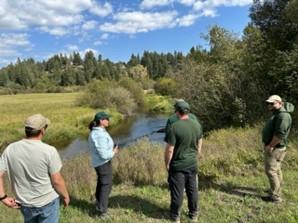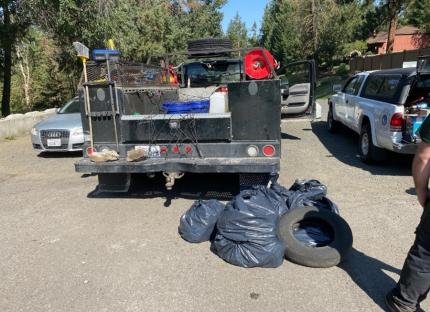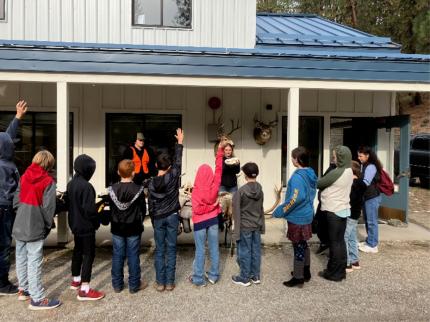Managing Wildlife Populations
Grizzly Bear Monitoring: Wildlife Biologist Prince assisted a Kalispel tribal biologist with removing their last two 2023 hair corrals from within the Selkirk grizzly bear recovery area. Wildlife Biologist Turnock was assisted by a Kalispel tribe biologist with removing two Washington Department of Fish and Wildlife (WDFW) hair corrals from the Selkirk grizzly bear recovery area.
Deer: Biologists Lowe and Brinkman continued the second round of fall deer surveys. These roadside surveys cover similar routes to those driven in August, but the results are used to estimate fawn-to-doe ratios instead of buck-to-doe ratios which were calculated in August. The surveys are conducted for two to three hours around dawn or dusk, during the cooler times of the day, as this is typically when deer are more active. Locations are recorded for each group of deer observed, and composition of the groups are also documented (i.e., how many does, bucks, and fawns in each group).
Deer Survey: Acting Private Lands Biologist Nizer and Natural Resource Technician Rumiser completed two deer surveys near Hay and Dusty areas for District Wildlife Biologist Lowe. The most deer were seen on the second survey outside of Dusty with a total of 126 deer seen in 38-mile stretch.
Elk Calf Survival Study: Scientific Technician Moberg continued monitoring collared elk calves in the Blue Mountains. She conducted one mortality investigation, which was likely a cougar predation. Field necropsies on carcasses, along with predator DNA sampling, help to support predation evidence.
Chronic Wasting Disease: Wildlife Conflict Specialist Kolb retrieved samples for chronic wasting disease (CWD) testing throughout the week.
Natural Resource Technician Heitstuman checked local pits for CWD samples. One ungulate reported injured was put down and was sampled for testing then disposed of in the Washington Department of Transportation pit. Additionally, three reported road killed deer were recovered, sampled for testing, and disposed of in the Department of Transportation pits.
Wildlife Area Manager Dingman collected CWD samples from a roadkill doe along Patit Road and a buck at the Delaney Department of Transportation pit. Natural Resource Technician Tritt collected a CWD sample from a deer at the Delaney Department of Transportation pit on his way to pick up the CWD trailer from Garfield County Fairgrounds where it had been over the weekend. Dingman and Tritt participated in the CWD Check Station Logistics meeting. Tritt participated in the CWD Technician meeting.
Bird Survey Transects: Sherman Creek Wildlife Area Assistant Manager Palmer and Wildlife Area Manager Anderson met with Spokane Audubon Society’s Dr. Thorburn and Haggen on Thursday. Thorburn and Haggen are planning expansion of breeding bird survey efforts at Sherman Creek Wildlife Area, which help staff members compare bird use in different habitat types and before and after habitat treatments. Palmer mapped out six transect routes (five plus the existing route) with five “stop and listen” points per each one-mile transect. The four drove all six routes together and made minor adjustments to the listening point locations. Starting in 2024, Audubon members will be surveying two transects per year, completing the entire set every three years.

Providing Recreation Opportunities
Access Program: Acting Private Lands Biologist Nizer met with two landowners that are deciding to join the Hunt by Written Permission Program. One of the landowners is in Albion (Whitman County) along the South Fork of the Palouse River and has about 100 acres of land that provides hunting for big game, upland, and waterfowl access. Nizer is planning habitat work on land that used to grow alfalfa, and the landowner wants to transition it to a native grass stand. Nizer coordinated with Private Lands Biologist Baarstad to use a native seed mix he has available for the project. They also planned tree plantings on the site in the coming spring. Nizer met with another landowner in Lamont that has about 3,500 acres that he wants to enroll in the Hunt by Written Permission Program. Wildlife Conflict Specialist McCarty, Acting Private Lands Biologist Nizer, and Natural Resource Technician Rumiser met with the landowner to discuss the options and benefits of the program. The landowner plans to send maps of the property. He plans to sign a contract within a couple weeks, hopefully before modern deer season.
Nizer met with an existing landowner outside of Uniontown that wanted to enroll 200 more acres into a new contract. Nizer created the new contract with maps and submitted for approval. Nizer and Rumiser posted the property with access signs.
Access Site Tours: This week Wildlife Area Program Manager Robinette, Access Manager Dziekan, Region 1 Real Estate Specialist Stallinga, Access Habitat Technician Brant, Wildlife Area Assistant Manager Rimmelspacher, and Wildlife Area Manager Finch took a walking tour of the Waikiki Springs Access Area and they visited the Chapman Lake parcel, the proposed Department of Natural Resources trade to WDFW. Dziekan led a very detailed tour of both sites and explained the plans for the development of the Chapman Lake parcel. The group then went to the Waikiki Springs Unit and Dziekan explained all the habitat work that has been done over the last few years and the management issues to consider for that unit.


Waikiki Springs Volunteer Project: Inland Northwest Land Council (INLC) hosted a volunteer project at Waikiki Springs Wildlife Area. Access Manager Dziekan and Natural Resource Technician Brant were on-hand that day to represent the agency and help with the clean-up. Dziekan and Brant met with INLC and a group of 12 volunteers, half of which were parents and children in the Girl Scouts, on Saturday, Sep. 16 for a volunteer work project at the Waikiki Springs Wildlife Area. The volunteers picked up litter along the switchback trails. The date of the work project was picked because it was World Cleanup Day, an event aimed at promoting litter cleanup using volunteer service. In total, the group filled six large trash bags to the brim with litter, and a tire. Volunteers spent two hours on Saturday picking up the litter and left with a sparkling clean switchback trail without a piece of litter in sight. There were lots of small children, but no photos of the kids were taken since no releases were signed prior.

Access Program: Acting Private Lands Biologist Nizer coordinated with a landowner in Albion to enroll in the Hunt by Written Permission Program. Nizer created the landowner's contract and is waiting for approval to have it signed. The property is about 100 acres and is prime habitat for deer, waterfowl, and upland bird. This property will be a highly sought after piece as it is in an area where a lot of hunters drive by.
Contracts: Private Lands Biologist Hadley contacted and met with landowners to extend existing WDFW access contracts expiring soon. Also, he contacted landowners enrolled in WDFW’s Voluntary Public Access Program (VPA) to extend their program an additional year.
Providing Conflict Prevention and Education
Producer Check-In: Wildlife Conflict Specialist Kolb conducted check-ins with producers in the Touchet pack territory and informed them of a recent collaring effort. Wolf Biologist Spence successfully deployed a GPS collar within the Touchet pack. Producers with existing data sharing agreements are now able to view the collar data to aid in range rider deployments and other non-lethal applications.
Depredation Investigation: Wildlife Conflict Specialist Wade and Wildlife Conflict Supervisor McCanna conducted an investigation of two injured calves this week. Both calves were determined to be non-depredations.
Conserving Natural Landscapes
Shrub Order: Private Lands Biologist Hadley coordinated with Private Lands Biologist Baarstad and Plants of the Wild and Wild Lands to complete shrub orders to complete planting plans for this fall and next spring planting projects in Columbia and Walla Walla counties.
Habitat Projects: Private Lands Supervisor Earl met with the local Conservation Districts to discuss potential joint projects. Earl also worked with the Regional Private Lands staff members to put together a large, combined order for trees and shrubs. Earl met with Private Lands Biologist Baarstad to transfer a seeder from Pomeroy to be used on projects in Lincoln County.
Conservation Reserve Program Enhancement: Acting Private Lands Biologist Nizer and Natural Resource Technician Rumiser visited a Conservation Reserve Program site that is enrolled in the feel free to hunt access and conducted weed management by spraying for invasive weeds with the tractor.
W. T. Wooten Wildlife Area Shooting Range: W. T. Wooten Wildlife Area staff members finished rebuilding the fence at the entrance to the Wooten Shooting Range and got the new gates hung. Natural Resource Technician Tritt and Jensen built rests for the gates to sit on while open and placed a large boulder near the corner of one of the gates to keep people from driving into it.




Providing Education and Outreach
Hunter Education: Wildlife Conflict Specialist Kolb assisted with the coordination, teaching, and delivery of more than 24 total hours of instruction for hunter education. Over the course of a one-week period, Walla Walla instructors taught both a traditional class and an on-line class and successfully certified 30 students in hunter education which included an in-depth live-fire field day evolution.
Water Festival: Each year, the Lake Roosevelt Forum sponsors Water Festival, two days of kids’ field trips, where natural resource professionals provide hundreds of area schoolchildren with information about what they do. As they did last year, Sherman Creek Wildlife Area staff members gave a presentation titled “Who’s for Dinner.” Natural Resource Technician Zueger and Wildlife Area Manager Anderson taught about 150 kids from several different schools about upland predators and prey, and the adaptations that ensure their success. The crew had assistance from four high school student assistants (two each day), and on the second day from Chronic Wasting Disease Technician Duncan. The students and Duncan were very helpful and happy to actively participate in presenting information.

Bear Safety: Biologist Brinkman participated in a bear safety event with local hiking groups at the new library in Spokane Valley. This event reached approximately 60 people and focused on techniques for staying safe in bear country, including a demonstration on the proper use of bear spray using inert canisters.


National Hunting and Fishing Day: Biologists Lowe and Brinkman participated in the National Hunting and Fishing Day event at Diamond Lake. The event was intended to introduce youth to hunting, fishing, and the outdoors. It included activities such as catching fish from the dock, shooting firearms and bows, visiting a backcountry camp setup, and talking to falconers that brought live raptors to their booth. Biologists Lowe and Brinkman assisted at the art tent where kids could make their own fish prints using a form of art known as gyotaku, take a plaster cast of animal tracks, build butterfly houses, and draw/color on various coloring sheets. Approximately 600 kids were registered for the event.


Hunter Education: Wildlife Conflict Specialist Kolb, Hunter Education and Volunteer Coordinator Dazey, and Chief Hunter Education Instructor Hall presented an appreciation plaque to the Walla Walla County Fire District 4. They have provided unwavering classroom support to recent hunter education classes which has made a substantial difference in how classes are delivered to students.

Camp Wooten: Wildlife Conflict Specialist Kolb and Wooten Wildlife Area Manager Dingman taught a full day of classes to 6th grade students at Camp Wooten. The classes covered Blue Mountain wildlife species the students could see during their stay at Camp Wooten.